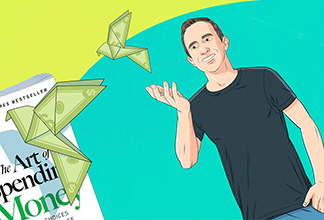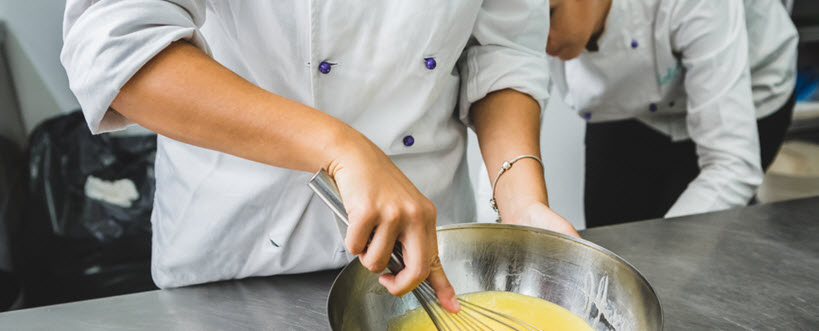How RRSPs Can Help With Going Back to School
Written by Bonny Reichert
Published on September 12, 2017
minute read
Share:
When I hit a certain milestone birthday, I knew it was time for a change. I had worked hard to reach management level at a national magazine, but with three kids at home and a partner who travelled for work, I was feeling burned out and overwhelmed.
"Although I knew my tuition was tax deductible, there was another break for adult students that I wasn't aware of at the time."
Meanwhile, office politics and a heavy workload were leaving little time for the creative tasks that had drawn me to the job in the first place. Although looking for a different job seemed like the responsible thing to do, what I really wanted was to go to chef school. But was I really going to quit a good job — a potentially irreplaceable job — just to chase this rainbow? How would we afford it? What would I do with my chef training when I finished school?
The decision to go back to school as an adult can mean a huge financial investment. Although I knew my tuition was tax deductible, there was another break for adult students that I wasn't aware of at the time.
It comes from the federal government in the form of the Lifelong Learning Plan (LLP). Here's how it works: The LLP helps you pay for new training or education by allowing access to Registered Retirement Savings Plan (RRSP) funds. It's much like the more common Home Buyers' Plan, which allows first-time home buyers to access RRSP savings for a down payment. Under the LLP, you can withdraw up to $10,000 each calendar year, to a total of $20,000 over four years, for full-time training or post-secondary education. The money is not subject to taxes when you withdraw it, but each year you do have to pay back at least 10 per cent of the amount borrowed. The full amount must be repaid within 10 years. You or your spouse can be the student making use of the funds, but not your kids.
"At chef school, I learned how to filet a whole fish and flambé a steak. I studied butchery, budgeting, pastry and plating. I also learned to trust my instincts and give myself room to take a chance."
Since I didn't know about that option, the way I did things played out a little differently. I gave up my full-time childcare and hired a young sitter to cover only the hours when both my partner and I had to be out. I dipped into my rainy-day savings for my tuition, and guiltily left paying all of the household bills to my partner.
I grew up in a restaurant-business family, and had always loved being around and working with food. But up until that point, cooking was just a hobby; a release, something I did for pleasure. At chef school, I learned how to filet a whole fish and flambé a steak. I studied butchery, budgeting, pastry and plating. I also learned to trust my instincts and give myself room to take a chance. I believed in what I was doing, but man, was I ever tired!
About halfway through the first year, I stopped thinking I had chosen the most self-indulgent path possible and gave myself permission to absolutely love what I was doing. My program was two years, and right after completing it, I started working as a food journalist — editing a food magazine one year, developing recipes and researching food trends the next. The work I was able to take on with my additional training more than paid for chef school, and opened an entirely new avenue in my career and a renewed income stream.
The decision to invest in myself changed not only my financial future, but my future in general. And according to my friends and family, I'm not a bad cook, either!
The information provided in this article is for general purposes only and does not constitute personal financial advice. Please consult with your own professional advisor to discuss your specific financial and tax needs.
RBC Direct Investing Inc. and Royal Bank of Canada are separate corporate entities which are affiliated. RBC Direct Investing Inc. is a wholly owned subsidiary of Royal Bank of Canada and is a Member of the Investment Industry Regulatory Organization of Canada and the Canadian Investor Protection Fund. Royal Bank of Canada and certain of its issuers are related to RBC Direct Investing Inc. RBC Direct Investing Inc. does not provide investment advice or recommendations regarding the purchase or sale of any securities. Investors are responsible for their own investment decisions. RBC Direct Investing is a business name used by RBC Direct Investing Inc. ® / ™ Trademark(s) of Royal Bank of Canada. RBC and Royal Bank are registered trademarks of Royal Bank of Canada. Used under licence. © Royal Bank of Canada 2019. All rights reserved.
The views and opinions expressed in this publication are for your general interest and do not necessarily reflect the views and opinions of RBC Direct Investing. Furthermore, the products, services and securities referred to in this publication are only available in Canada and other jurisdictions where they may be legally offered for sale. If you are not currently resident of Canada, you should not access the information available on the RBC Direct Investing website.
Explore More

What Investors Should Know About the Precious Metals Market
Factors influencing silver, platinum and palladium
minute read

The Art of Spending: 5 Takeaways from Morgan Housel’s New Book
Ideas for how to build a healthier relationship with money and how you spend it
minute read

Should I Invest or Pay Down My Mortgage?
Consider these four questions
minute read
Inspired Investor brings you personal stories, timely information and expert insights to empower your investment decisions. Visit About Us to find out more.







